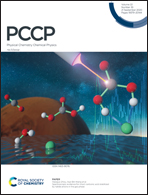Multidimensional B4N materials as novel anode materials for lithium ion batteries†
Abstract
Based on first-principles calculations and ab initio molecular dynamics simulations, multidimensional B4N materials are investigated as anode materials for lithium ion batteries. The present results show that the monolayer B4N can reach a remarkably high specific capacity of 1874.27 mA h g−1 and possesses a low diffusion barrier (0.29 eV). Testing of bilayer B4N and bulk B4N reveals that the materials exhibit irreversible structural phase transformation. They are transformed from a layered structure to the more stable cavity–channel structure due to the adsorption of Li atoms. The volume expansions of their saturated lithiation cavity–channel structures are about 12%, which is close to that of graphite (10%). Moreover, it is found that the energy barriers of the bilayer and bulk B4N are less than 0.5 eV in the cavity–channel. The saturated adsorption of bulk B4N yields a specific capacity of 468.57 mA h g−1, which is higher than that of commercial graphite (372 mA h g−1). More importantly, all the lithiation structures in the monolayer, bilayer, and bulk B4N are verified to be thermodynamically stable at 350 K. These findings may encourage further experimental investigation in the design of multidimensional B4N materials as novel candidate anode materials for lithium ion batteries.



 Please wait while we load your content...
Please wait while we load your content...